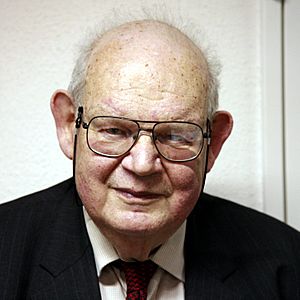Benoît Mandelbrot facts for kids
Benoît B. Mandelbrot (born November 20, 1924 – died October 14, 2010) was a famous mathematician. He was born in Warsaw, Poland, into a Jewish family. He later became a citizen of France and the United States. Mandelbrot is best known for his amazing work with fractal geometry. He lived and worked in the United States until he passed away. He was also a professor at Yale University.
Benoît Mandelbrot's family moved to France when he was young. They lived there during the German occupation. He died at the age of 85 in Cambridge, Massachusetts.
His most famous discovery is the Mandelbrot set. He found and described this special set of shapes in 1979.
What Are Fractals?
Fractals are special shapes that look the same no matter how much you zoom in on them. Imagine a coastline: if you look at it from far away, it has a certain jagged shape. If you zoom in on a small part of that coastline, it still looks jagged, with similar patterns repeating. That's the idea behind fractals!
Mandelbrot was the first to use the word "fractal." He showed how these complex, repeating patterns appear everywhere in nature. You can see them in things like clouds, snowflakes, mountains, and even the branching of trees.
The Mandelbrot Set

The Mandelbrot set is a very famous example of a fractal. It's a collection of points on a graph that create a beautiful, infinitely complex shape. This shape is made using a simple mathematical rule, but it creates endless detailed patterns.
When you zoom into the edges of the Mandelbrot set, you find tiny copies of the whole shape. You also find many other unique and colorful patterns. This discovery helped people understand how simple rules can lead to incredibly complex and beautiful designs in mathematics and nature.
Images for kids
-
Mandelbrot speaking about the Mandelbrot set in 2006.
See also
 In Spanish: Benoît Mandelbrot para niños
In Spanish: Benoît Mandelbrot para niños





